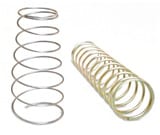 Compression spring uses are many. It is the most common type of spring and is designed to function when a load is applied to it. Made of spring steel, or another non-ferrous metal, a compression spring is an elastic coil that very efficiently builds up energy when loaded. When you think compression spring, think mattress springs, upholstery springs or even a pogo stick—each carry a load.
Compression spring uses are many. It is the most common type of spring and is designed to function when a load is applied to it. Made of spring steel, or another non-ferrous metal, a compression spring is an elastic coil that very efficiently builds up energy when loaded. When you think compression spring, think mattress springs, upholstery springs or even a pogo stick—each carry a load.
Compression springs, as the name suggests, absorb force or provide resistance when the spring coil is being compressed. In an unloaded state, the spaces between the spring are visible through its coil. When loaded, the spaces between the coils are compressed, creating the necessary energy to carry the load. However, for a compression spring to operate effectively, the coils must never compress to the point that they are in contact with each other. If so, then the load is either too heavy or the spring is shot or both, and its service life has ended.
What are common compression spring uses?
A compression spring comes in many configurations, shapes and sizes. They are conical, hourglass and barrel of varying lengths—and can be used as a shock absorber, vibration damper, a pure energy accumulator, or force generator. Because of their versatility, how efficiently they store energy and the multiple shapes in which they can be manufactured, these types of mechanical springs have a wide selection of applications.
Consider your car. In the automotive industry, compression springs are used throughout the vehicle. As the springs can be manufactured to tight tolerances, they are used in the engine around shafts or placed in small holes while in a vertical position. Look under any vehicle at the suspension system. It is compression springs that absorb the shock of the road while driving to provide a comfortable ride. The springs also help to absorb various types of vibrations and resonances while driving. They also add to your personal comfort as part of most seating assemblies.
Medical applications for compression springs are used as parts in assembling a device. They also implanted straight into a patient’s body. For example, so specialized are the springs for arterial widening—not only the materials but also for the extremely small dimensions to .030 mm.
High energy rated industrial compression springs is used in the manufacturing of mining machinery, too, for drilling and other related equipment.
How indispensable are compression springs?
Original equipment manufacturers (OEMs) that produce products for various industries that use compression springs need compression springs in their machinery in order to produce those parts and products. Compression springs are used in such industrial sectors as manufacturing, transportation, construction, agriculture, petrochemical, and aeronautical.
Compression spring applications in the everyday products, machines, and devices we use in home, office, on the job, or in school, are so varied and common we don’t even realize how much a part of our lives compression springs are. They are found in pens and notebooks, mattresses, flashlights, tools, toys, armchairs, small electronic devices, countertop kitchen equipment, electrical light switches, precision instruments, lawn mowers, washing machines, and more. Industry-specific spring applications are easy to overlook as well – for example, in the medical field, medical compression springs are used for a variety of equipment, from syringes to inhalers.
Compression spring uses are seemingly endless. From automotive springs to medical compression springs, these springs play an important role in all facets of today’s industrial world. They allow for the efficient and safe operation of machines, devices, tools and components, and undoubtedly is the main reason that they have become the most commonly used spring on the market.
To learn more about our products and industries served, contact us at James Spring & Wire Company today.

